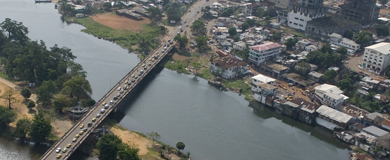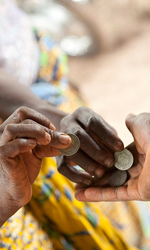Research Brief
How to Achieve Economics of Peace?
- The natural resource sector in Liberia has failed to produce links to other important sectors of the economy, and in particular has failed to create jobs for the large majority of the population.
- Creating new and productive jobs is key to national reconciliation.
- The aid community needs to distinguish between the economics of development and the economics of peace.
A study of the Liberian case
In 2003 the fourteen year civil war in Liberia was brought to an end. Permanent peace, however, is by no means assured even ten years later. Around half of the countries that embark on the all-important transition from war to peace slide back into conflict. Of the half that manages to keep the peace the vast majority become highly dependent on aid. This is at least in part due to the fact that the aid community often fails to distinguish between the economics of development and the economics of peace.
Peace in Liberia
Between 150,00 and 300,000 people died during Liberia's fourteen-year civil war, which was brought to an end by the 2003 Accra Comprehensive Peace Agreement. The conflict was caused by 'native' Liberians grievances against the former slave and freeborn blacks who came from America to settle in Liberia in the 1820s. The 'Americo-Liberians' founded the republic of Liberia in 1947, held power until a coup d'etat in 1980 at which time 4 per cent of the Liberian population owned 60 per cent of the wealth.
 Liberia's economic recovery since the conflict has largely been based on natural resource exploitation, which generates most of the country’s output, foreign exchange and fiscal revenue. However the natural resource sector has failed to produce links to other important sectors of the economy, and in particular has failed to create jobs for the large majority of the population, which lives from subsistence agriculture and petty trading. Creating new and productive jobs is key to national reconciliation both because they give former combatants a means to provide for themselves and their families, and because it integrates them into the process of rebuilding the national economy.
Liberia's economic recovery since the conflict has largely been based on natural resource exploitation, which generates most of the country’s output, foreign exchange and fiscal revenue. However the natural resource sector has failed to produce links to other important sectors of the economy, and in particular has failed to create jobs for the large majority of the population, which lives from subsistence agriculture and petty trading. Creating new and productive jobs is key to national reconciliation both because they give former combatants a means to provide for themselves and their families, and because it integrates them into the process of rebuilding the national economy.
This problem has been recognized by the Liberian government. Their 2008-11 poverty reduction strategy emphasized the need to improve infrastructure, and increase the provision of local services. However public services such as healthcare and education are still lacking and the improvements to infrastructure have largely benefited foreign concessions producing commodities for export. The Liberian government has now adopted a new eighteen year strategy called ‘Liberia Rising’, which aims to make Liberia a middle income country by 2030. However, in order to achieve a sustainable peace and become less reliant on the UN Peacekeeping Operation for security, it is of paramount importance to quickly integrate former combatants and other war-affected groups into the economy. For this aim, the development strategy pursued by the Liberian government is too long term in nature. Pursuing the typical development policy of focusing purely on economic growth may have tragic consequences for Liberia, the special needs of a post-conflict society have to be taken into account promptly to avoid the country relapsing into conflict.
The Economics of Peace vs. the Economics of Development
The economics of peace should be seen as an intermediate period between the economics of war, where the underground economy dominates, and the economics of development, which focuses on medium- and long-term objectives of economic growth and structural improvements. There are a number of ways in which the economics of peace must differ from the normal development agenda.
- Policies during the economics of peace may need to be short term and emergency in nature, so as to ensure that the country does not revert to conflict, even if this means that these policies are less than optimal in the long run.
- Former combatants and other war-affected groups need to be reintegrated into productive activities as soon as possible, so that they have a stake in the peace process.
- The traditional development principle that all groups with the same need should be treated equally may need to be put aside. In some cases it will be necessary for special attention to be given to those most affected by the conflict, or those most likely to revert to it.
- Aid always presents opportunities for corruption, and the extraordinarily high levels of aid received by post-conflict countries, which often ranges from 50-100 per cent of GDP, considerably exacerbates this problem. In order to avoid this, greater attention must be paid to how aid is utilized during this the economics of peace to ensure that it supports, rather than weaken the process.
- Policies during the economics of peace must be focused on the speedy creation of an economy that is inclusive and self-sustainable. Post-conflict societies receive a large amount of humanitarian aid to save lives and ensure minimum levels of consumption. If prolonged, however, this aid would discourage production and labor supply. By contrast, reconstruction aid is key to create investment and employment, to make life worth living and to ensure that the country can stand on its own feet.
As noted above, Liberia's current development policy is based on improving the country’s infrastructure and service industry, mostly benefiting the large foreign concessions. This is important, but when the special requirements of the economics of peace are taken into account, a better policy would be to focus on specific areas of the country to quickly create jobs for the vulnerable, a level-playing field in infrastructure, services and credit for the micro- and small enterprises and farmers, and economic linkages between the export industry and local production. These areas should be seen as “reconstruction zones”.
 Reconstruction Zones in Liberia
Reconstruction Zones in Liberia
Reconstruction zones would be made up of two different, but linked, areas; local production reconstruction zones (LRZs), and export-orientated reconstruction zones (ERZs), which would consist of the existing foreign concessions. Locating such zones close together would enable the creation of synergies between the two, and thus help overcome the problem of Liberia's successful natural resource driven export sector not really contributing to local development. Furthermore, in LRZs rural development could follow a more integrated strategy based on local needs and priorities; this would help Liberia also raise the level of food security in the country. This policy falls within the government’s current strategy, but would have the added benefit of creating the urgently needed employment opportunities for the vulnerable.
The importance of an integrated approach is demonstrated by a common failing of many development strategies. That is that they educate people for jobs that don't exist, or build roads in areas where there is not enough productive activities for them to be used, building schools for which there are no teachers, or providing seeds to farmers who don't have the technical skills necessary to use them. The fact that RZs would focus on specific geographic areas would allow for a more integrated development strategy in the areas in questions, which would in turn help avoid the kind of problems that Liberia faces today. Furthermore, a more integrated strategy with strong links between the export sector and the domestic economy would also encourage more rapid development than otherwise, which, as already noted, is particularly important in post-conflict societies.
- During the economics of peace aid should focused on specific areas of the country to quickly create jobs for the vulnerable.
- These areas can be seen as “reconstruction zones” and should be designed to foster both local reconstruction and exports.
- Reconstruction zones could help to create a virtuous circle between growth, poverty alleviation, better access to resources and opportunities, improved living conditions for the large majority of the population, and peace consolidation.
Reconstruction Zones may be what is needed to create a virtuous circle between growth, poverty alleviation, better access to resources and opportunities, improved living conditions for the large majority of the population, and peace consolidation. If RZs can achieve this, then they represent a promising policy with the potential to prevent Liberia slipping back into a conflict situation. While this type of RZ may not be the correct policy for all post-conflict societies, focusing on the economics of peace is key to ensuring that Liberia does not relapse into conflict and can eventually move into a normal development path.
 Join the network
Join the network